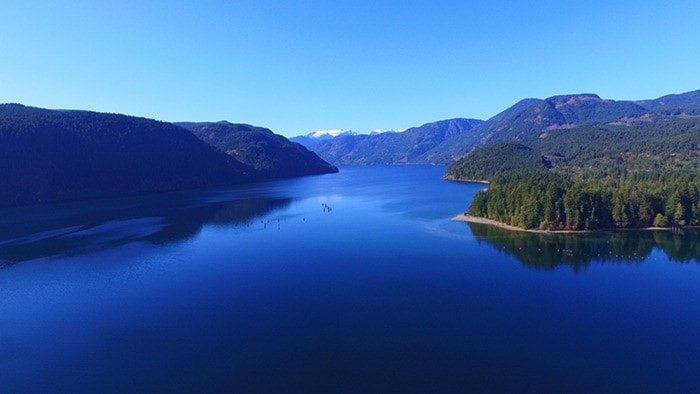The Comox Valley has received a number of boil water notices in recent years — seven to be exact, since November, 2014. The latest was issued Nov. 2 after intense rainfall caused an increase in turbidity levels in Comox Lake and the Puntledge River.
Turbidity, or murkiness, refers to fine suspended particles picked up by water as it passes through streams and rivers in a watershed. High turbidity can interfere with the chlorination process used to disinfect drinking water. The safety level is around 1 NTU (nephelometric turbidity units).
“There isn’t anything else to deal with any other pathogens in the water, except chlorine,” Chief Medical Health Officer Charmaine Enns said. “That means there’s an increased likelihood of pathogens impacting people.”
(Pathogens are micro-organisms, such as bacteria and viruses. Viral diseases that can be transmitted by water include rotavirus, enterovirus, norovirus and hepatitis A.)
Comox Lake is fed by six or seven major tributaries. Water samples are constantly monitored.
“We’ve pinpointed a few of the problems in the area. Perseverance Creek is one of them,” said Mike Herschmiller, the CVRD’s manager of water services. “In the rainstorms in the last three years, they’ve been more intense. What we’re noticing is the type of material we’re getting is the clay out of Perseverance Creek, which is small, light particulate that doesn’t settle very well. As glaciers recede, rock gets ground to dust which is carried into the lake through rivers and streams.
“It’s a huge lake — a big settling pond,” he added, in reference to Comox Lake. “When we get 50 NTU coming in from a tributary, but we have one-and-a-half NTU going out, there’s a lot of material that’s settling out as we go.”
The boil water notices — combined with water quality monitoring in the lake — have led Island Health to mandate filtering and disinfection for the Comox Valley water system, which serves about 45,000 people.
In 2013, Island Health granted a filtration deferral which would have made a deep water intake and a UV treatment facility sufficient technologies for the new water treatment plant. But last year, it rescinded that deferral due to increased turbidity in Comox Lake. This caused the CVRD to change its direction slightly and choose a filtration technology that would provide the best results to deal with turbidity.
The CVRD has until Sept. 30, 2019 to meet Island Health’s surface water treatment objectives.
“That’s the standard in the province,” Herschmiller said. “Filtration of surface water is not going to be an anomaly any more, it’s going to be the norm.”
A consultant recommends direct filtration as the best water treatment option. The cost will run about $105 million, which will include the following:
• a new deep water intake in Comox Lake;
•a new conveyance from intake to water treatment plant (a new pumping station will be needed near the intake location);
•a new water treatment plant with technology for filtration and disinfection; and
•a new treated water pipeline (to move water from the treatment plant to distribution system).
Grant funding opportunities are being explored.
The amount of government funding received will determine the magnitude of rate increases to users.
“A new treatment facility will filter out suspended solids (turbidity), including pathogens,” Herschmiller said. “I can’t guarantee the system will never have a problem again, but this facility will eliminate the need for turbidity-related boil water notices.”
Some suggest B.C. is taxed with onerous standards when it comes to water, but Enns said the province has minimal standards for surface water — based on a source-to-tap view that employs a multi-barrier approach, which includes water treatment.
“We’re actually behind much of the U.S. in terms of requirements,” she said. “We assume we have an endless supply, but it is a limited resource. And it’s used for more things than just drinking.”
A great deal of consultation occurs between various parties before a boil water notice is issued. When turbidity levels are high, an alarm sets off in a chlorination station, usually in the middle of the night during a storm. Officials will then verify readings at the station and penstock, and assess trending and reservoir levels — bearing in mind the 32 million litres of water in storage, held by six reservoirs around the Valley. In summer, this amount lasts about half a day, winter about two days, though some needs to be saved for fire protection.
The district will first discuss the situation with Comox and Courtenay before alerting Island Health, which issues the notice.
In the latest boil, officials were able to “fight it” for several days before receiving the “knockout blow,” Herschmiller said.
Residents are advised to boil water for a minute.
“I would encourage people to take it seriously,” Enns said. “It is true that some people are more impacted than others. It’s usually the younger children under five years and seniors. And people who have underlying chronic disease who are more susceptible to disease.”
From the time a notice is issued, Enns said there is a lag of about six to 12 days before an increase in gastro-intestinal illness becomes evident.
“You can’t pick and choose in a community who you say should protect themselves,” Herschmiller said. “You need to have the greater good of the community at the forefront of the decisions. That’s why these boil water notices are important.”
